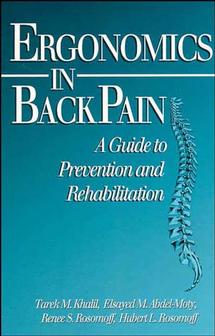Back pain is a leading cause of suffering, high medical costs, andloss of productivity in the workplace. Through a multidisciplinaryapproach, this book addresses the widespread problem ofmusculoskeletal injuries in general and lower back injury inparticular. It presents the principles of ergonomics andbioengineering and their application to the prevention andrehabilitation of lower back injuries. Special attention is givento ergonomic methodologies such as human performance analysis andfunctional capacity assessment. Ways to structure workplaces andjob tasks so as to minimize stresses to the back and improveproductivity are presented. Case studies and population profilesare drawn from ergonomic research performed at the ComprehensivePain and Rehabilitation Center at the University of Miami. Theauthors discuss the origins of low back pain, events that lead toinjury, and the consequences to employers. Back pain is correlatedwith specific occupational factors. Nearly 150 illustrationsfurther these discussions. Among the important preventive andtherapeutic measures explored are:<br> * Bodymechanics education and muscle reeducation<br> * Workplace design and biomechanics<br> * Functional electrical stimulation, electromyography, andbiofeedback<br> * Management of low back pain during rehabilitation andpost-rehabilitation stages<br> Extensive epidemiological data show the devastating effects of lowback pain on the economy, industry, and healthcare delivery. Alsoexamined are the role of medical personnel in the evaluation andtreatment of back pain and the contributions that can be made by anergonomist who is part of a multidisciplinary healthcare deliveryteam. Ergonomics in Back Pain is intended for use by ergonomists,physicians, physical therapists, occupational therapists,vocational counselors, chiropractors, osteopaths, andrehabilitation medicine specialists, as well as by engineers,workplace designers, and people working on the implementation ofthe Americans with Disabilities Act.
Ergonomics in Back Pain
₹12,133.00
A Guide to Prevention and Rehabilitation
This book is currently not in stock. You are pre-ordering this book.




